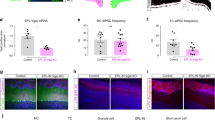Abstract
RECENT investigations1,2 on the electrically evoked potential in the vertebrate olfactory bulb propose a precise description of the components of the potential and some understanding of the neural elements generating the observable electrical phenomena. In the present work the turtle, Chrysemys picta belli, was used because the gross anatomical structure favoured investigation of some neural parameters. In this animal the primary olfactory fibres, easily accessible to the investigator, are grouped into large bundles terminating in different areas of the bulb. By electrically stimulating the separate bundles, spatially distinct areas of the bulb were activated and the resulting bulbar potential observed.
This is a preview of subscription content, access via your institution
Access options
Subscribe to this journal
Receive 51 print issues and online access
$199.00 per year
only $3.90 per issue
Buy this article
- Purchase on Springer Link
- Instant access to full article PDF
Prices may be subject to local taxes which are calculated during checkout
Similar content being viewed by others
References
Ottoson, D., Acta Physiol. Scand., 47, 160 (1959).
Iwase, Y., and Uruha, M., Science, 133, 884 (1961).
Green, J. D., Nature, 182, 962 (1958).
Author information
Authors and Affiliations
Rights and permissions
About this article
Cite this article
BOUDREAU, J., FREEMAN, W. Olfactory Bulb Response in the Turtle. Nature 193, 782–783 (1962). https://doi.org/10.1038/193782a0
Issue Date:
DOI: https://doi.org/10.1038/193782a0
This article is cited by
-
Effect of temperature change on evoked potentials of the fish olfactory bulb
Neurophysiology (1975)
-
Chronic Implantation of Electrodes into the Olfactory Bulb
Nature (1963)
Comments
By submitting a comment you agree to abide by our Terms and Community Guidelines. If you find something abusive or that does not comply with our terms or guidelines please flag it as inappropriate.



